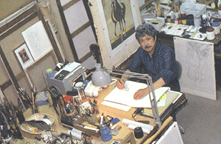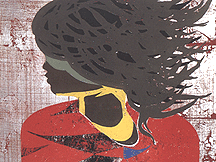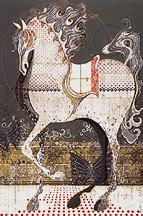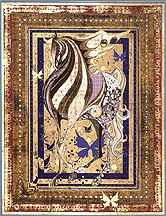In the print,
"Running Horses" which was released in 1984, one sees
a slight departure for Nakayama in the form of bold diagonal
lines of gold which draw one's eyes to the running horses, the
focal point of the print. These gold lines printed on a black
surface are a clue that Nakayama is slightly re-arranging his
concepts of space and emphasis; one is reminded of the structure
of some of the works of the 20th Century American Abstract Expressionists.
1990 - Begins
with the release of "Mirage in the Wind", this is the
beginning of the fourth period of his career. This print was
created on 35 woodblocks, printed with 47 colors in 51 stages
of hand-printing. In this print, the colors are brighter, clearer
and the strong diagonal lines are used to create motion. "Road
of the Butterflies Spring" released in 1991, again
uses diagonal lines to create emphasis and action culminating
in the center with the profile of a young girl with free, marvelously
flowing hair printed with dots of brilliant color. As Nakayama
continues to work, one will no doubt see other important developments
in the use of color and line in his prints.
Nakayama begins each print by drawing the
design on ordinary paper. After the design is completed, it is
painted with watercolors an he may add gold and silver to help
him visualize the final work. Next, Nakayama transfers each color
of the design onto separate sheets of tracing paper. For example,
every section of the print which will be magenta is traced onto
a separate sheet of paper, every section which will be cadmium
yellow is traced onto another sheet, etc....
When all of the areas of color have been transferred
onto sheets of tracing paper, the next step is to transfer the
image to the woodblocks, again using one block for each of the
different areas of color. Nakayama craves his blocks using chisels,
awls, knives and other tools. Upon completion of the carving,
he begins the printing of trial proofs. During this process,
he determines the order in which the colors and the leaf gold
and silver will be printed. Determining the order of colors is
influenced by the shadings of color he wishes to create and it
also depends to some extent on where the colors are locatd in
the composition. For example, when certain colors are printed
over others, a certain grain or striation might occur which Nakayama
does not want in his print. Experience has taught him the general
order of the application of colors and the optimum time for the
printing of 24 carat leaf gold and silver. Nakayama's goal might
be to achieve the clearest printing possible or it might be to
create a kaleidoscope of brilliance by overlapping colors.
Because Nakayama's prints are very complicated,
they are very time-consuming and he is able to complete only
one or two prints each year. He is the sole creator of his work
and until very recent years, he did all of the work of each print.
He drew the basic design, traced the colors onto the blocks,
carved the blocks, printed the trial proofs and final edition.
At this time, he receives some assistance in the carving of blocks
and in printing. However, all stages of carving and printing
are done under his supervision. He controls every stage of his
creativity.
When one compares the prints of Tadashi Nakayama
with those of a western artist, American or European, one is
struck by the intensity of the labor of technique and the expansiveness
of his creations. When one considers that his works are printed
on hand-made hosho paper, printed with hand pressure and absent
the usage of any machines, completed in the privacy of his home,
created totally by the artist, one marvels at the integrity of
the work. Consider the time-consuming manner in which the printing
is achieved which results in a total body of work of one or two
prints each year. When one considers the small editions of 85
or 95, one can realize the scarcity of these prints when one
understands the universal international appeal of his compositions.
Tadashi Nakayama, who was inspired by the
works of the Renaissance and the Persian and Indian artists through
the 17th century, is creating his works iin the 20th century
using an ancient Japanese woodblock printing technique--works
of such grace, beauty, fluidity of line and luxuriance of color,
that they will be even more appreciated in the 21st Century.






